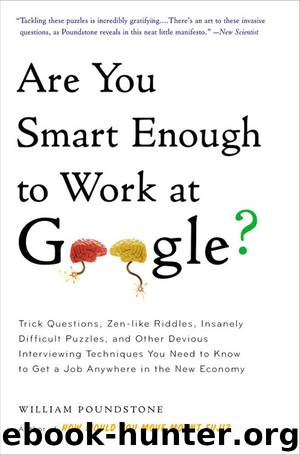Are You Smart Enough to Work at Google? by William Poundstone

Author:William Poundstone
Language: eng
Format: mobi, epub
ISBN: 9780316192972
Publisher: Little, Brown and Company
Published: 2012-01-03T16:00:00+00:00
Answers
With a standard logic puzzle, there’s a right answer; not so much with many of today’s most interesting interview questions. Where applicable, I point out both good and not-so-good answers and explain why there’s a difference. There are often other good answers. If you’ve got a better one, go for it.
Chapter one
? You are shrunk to the height of a nickel and thrown into a blender. Your mass is reduced so that your density is the same as usual. The blades start moving in sixty seconds. What do you do?
Those who were paying attention in rocket-science class will recall the formula for the energy of a projectile: E = mgh. E is energy (of a bottle rocket, let’s say), m is its mass, g is the acceleration of gravity, and h is the height the bottle rocket attains. The height increases in direct proportion with energy (as long as mass stays the same).
Suppose you tape two bottle rockets together and light them simultaneously. Will the double rocket go any higher? No; it’s got twice the fuel energy but also twice the mass to lift against gravity. That leaves the height, h, unchanged. The same principle applies to shrunken humans jumping. As long as muscle energy and mass shrink in proportion, jump height should stay the same.
? When there’s a wind blowing, does a round-trip by plane take more time, less time, or the same time?
The usual gut reaction is that the wind effects even out. A headwind will slow you one way; then it becomes a tailwind on the return and allows you to make up time. This is correct, as far as it goes. The question is, is the round-trip time exactly the same?
Say you’ve got a plane that travels from San Francisco to Washington and back at 600 miles an hour. Coincidentally, a freak of global warming has generated a steady, 600 mph jet stream blowing from San Francisco to Washington. This is great for the eastward trip. The hyperhurricane tailwind doubles the plane’s ground speed and allows it to arrive in Washington in half the usual time.
It’s the return trip that’s a killer. The plane has a 600 mph headwind. No matter how much the pilot guns the engines, it can’t overcome that. Even if the plane got in the air, its ground speed would be zero. (“Now, here, you see, it takes all the running you can do, to keep in the same place,” the Red Queen told Alice in Through the Looking-Glass.) The plane will never make it back to San Francisco. The “return trip” is of infinite duration, and so is the round-trip.
The predicament is easy to understand in this extreme case. On a 5-hour flight, a tailwind can save you (at the very most) 5 hours. A headwind can cost you an eternity. This basic principle is true no matter how fast or slow the wind is. A 300 mph wind would cut 1.67 hours off a 5-hour flight one way, but add 5 hours the other way.
Download
Are You Smart Enough to Work at Google? by William Poundstone.epub
This site does not store any files on its server. We only index and link to content provided by other sites. Please contact the content providers to delete copyright contents if any and email us, we'll remove relevant links or contents immediately.
| Business School Guides | GMAT |
| Guides | Interviewing |
| Job Hunting | Job Markets & Advice |
| Resumes | Vocational Guidance |
| Volunteer Work |
The Motivation Myth by Jeff Haden(5157)
Audition by Ryu Murakami(4851)
Adulting by Kelly Williams Brown(4488)
The Confidence Code by Katty Kay(4189)
A Mind For Numbers: How to Excel at Math and Science (Even If You Flunked Algebra) by Barbara Oakley(3221)
Waiting in the Wings by Melissa Brayden(3181)
Self-Esteem by Matthew McKay & Patrick Fanning(3093)
Fooled by Randomness: The Hidden Role of Chance in Life and in the Markets by Nassim Nicholas Taleb(3048)
The ONE Thing by Gary Keller(3010)
Nice Girls Don't Get the Corner Office by Lois P. Frankel(2996)
The Dictionary of Body Language by Joe Navarro(2947)
How to be More Interesting by Edward De Bono(2748)
Designing Your Life by Bill Burnett(2667)
Getting Things Done by David Allen(2646)
The Plant Paradox by Dr. Steven R. Gundry M.D(2548)
Police Exams Prep 2018-2019 by Kaplan Test Prep(2487)
What Color Is Your Parachute? 2015 by Richard N. Bolles(2264)
Dangerous Personalities by Joe Navarro(2234)
When to Jump by Mike Lewis(2204)
